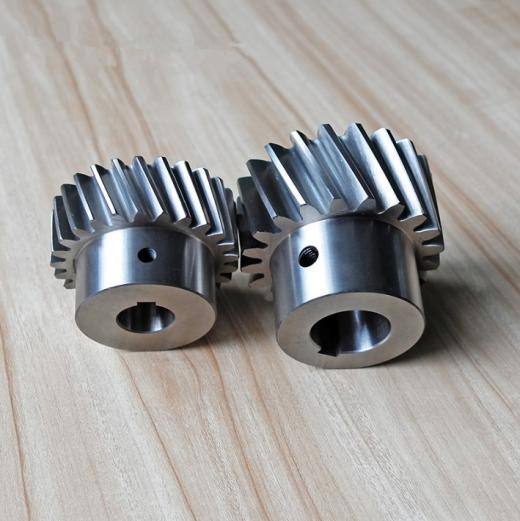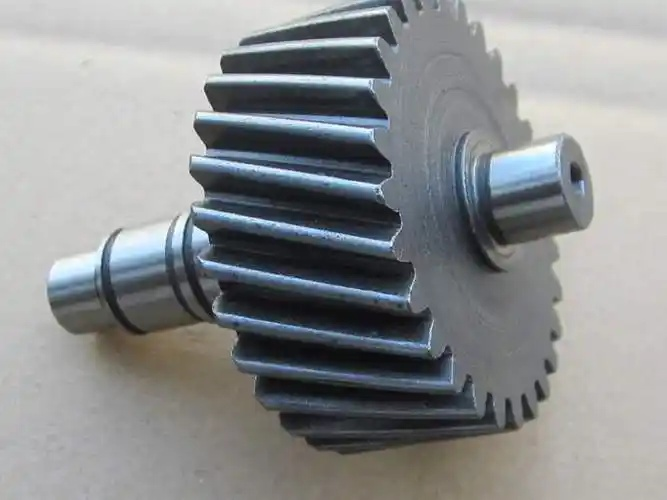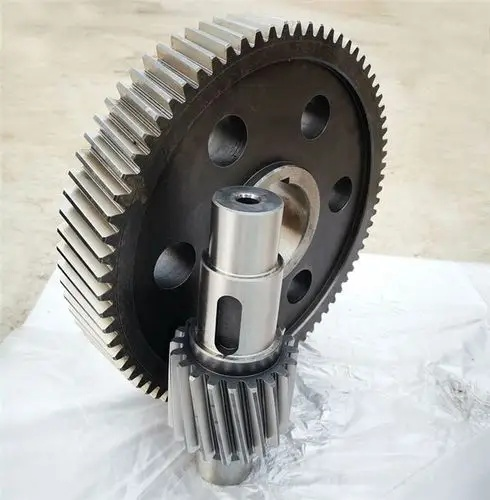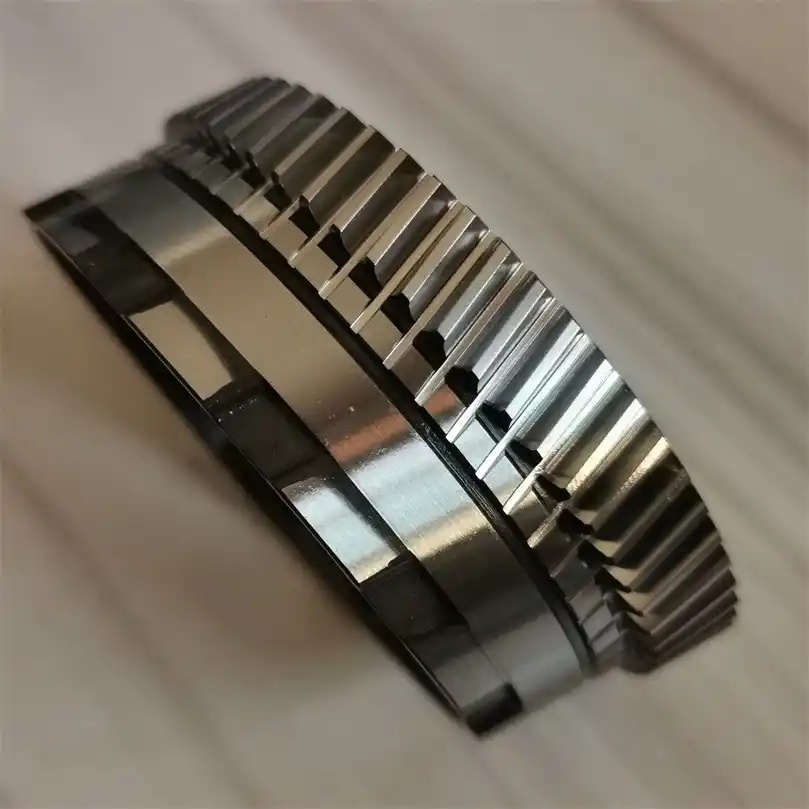I. The “Diagonal Engagement” of Helical Gears: A Structural and Conceptual Revolution
The “diagonal engagement” of helical gears is not merely a geometric refinement—it represents a fundamental breakthrough in mechanical transmission design. Unlike spur gears, whose teeth mesh vertically, helical gears feature a spiraled tooth profile that transforms the engagement process from a direct impact into a gradual, continuous contact.
In practice, the meshing of helical gears occurs in three distinct stages. At the initial contact, only a small portion of the tooth surface engages, dispersing impact forces. In the mid-stage, multiple teeth engage simultaneously, balancing the load. Finally, as the teeth disengage, the contact area gradually decreases, minimizing unloading shock. This “soft-landing” engagement raises the overlap ratio—defined as the number of teeth in simultaneous contact—by more than 30% compared to spur gears, resulting in a 50% improvement in transmission smoothness.
From a mechanical perspective, the helix angle of helical gears creates a dynamic balance between axial and radial forces. For instance, with a 15° helix angle, the axial force is only 26% of the radial force. In herringbone gear designs, where left- and right-hand helices are combined, this axial component can be entirely neutralized—effectively eliminating vibration and noise caused by axial impact in traditional spur gears.
II. The “Precision Dancer” of Robotic Joints: Meeting Grade 5–10 Accuracy Requirements
In industrial robot joints, helical gears act as “precision dancers.” Their accuracy directly determines the robot’s repeatability (±0.01 mm) and trajectory precision (±0.1°). For a Grade 5 helical gear, tooth profile error must be controlled within ±5 μm—about one-fifteenth the diameter of a human hair.
This stringent requirement arises from the compound motion of robot joints. In a six-axis robot, helical gears must withstand torque, axial, and radial loads simultaneously. Traditional spur gears, when subjected to multidirectional loads, tend to suffer from uneven tooth stress, degrading precision. The helical design distributes loads evenly along the tooth’s helical line, improving stress uniformity by 40%.
In real-world applications, Kubic Intelligent Equipment’s seventh-axis robotic system achieves ±0.02 mm positioning accuracy for battery module assembly through helical gear transmission. Its core advantage lies in a precision grinding process that reduces surface roughness to Ra 0.4 μm. Combined with a dynamic lubrication system, the gear pair maintains its initial precision even after 100,000 operating cycles—raising the pass rate of EV battery assembly from 92% to 98.7%.
III. The “Power Core” of New Energy Vehicles: Overcoming Three Major Engineering Challenges
Electric vehicles demand exceptional performance from their transmission systems: over 98% transmission efficiency, stable operation from -40°C to 120°C, and interior noise below 65 dB (roughly the volume of a quiet conversation). Helical gears meet these challenges through three key technological breakthroughs.
1. Balancing Lightweight Design and High Strength
Conventional spur gears must use high-carbon steels like 42CrMo to ensure strength, increasing gear weight by 15%. Helical gears, through helix-angle optimization, raise tooth contact strength by 25% under the same module, enabling the use of aluminum alloys (density 2.7 g/cm³) to replace part of the steel structure. This achieves a 30% weight reduction without compromising torque capacity.
2. Addressing High-Speed Operation and Noise Reduction
EV motors can reach rotational speeds up to 16,000 rpm—four times that of internal combustion engines. At these speeds, spur gears can generate piercing noise levels above 120 dB. The progressive meshing of helical gears distributes impact energy across 3–5 teeth, reducing noise below 75 dB. In Tesla’s Model 3, adopting helical gears lowered cabin noise from 78 dB to 68 dB—equivalent to luxury-vehicle standards.
3. The Art of Balancing Efficiency and Reliability
The helix angle of helical gears delivers transmission efficiency as high as 97%, about two percentage points higher than spur gears. In BYD’s Han EV drivetrain, frictional losses from helical gears account for only 1.2% of input power—compared to 3.5% for spur gears. For an annual driving distance of 20,000 km, this translates to approximately ¥400 in energy savings per year.
IV. The “Precision Revolution” in Manufacturing: From Hobbing to 3D Printing
The intelligence of helical gears extends beyond design—it also lies in advances in manufacturing technology. Traditional hobbing of helical gears requires five-axis CNC machines and involute generation, but precision was long limited by tool wear. Modern production has overcome these limits through three major innovations.
1. The Precision Revolution of Gear Grinding
Using CBN (Cubic Boron Nitride) grinding wheels, tooth profile error can be reduced to within ±2 μm. In EV differential gears produced by Shuanghuan Transmission, gear backlash uniformity reaches 0.005 mm—equivalent to one-twentieth the thickness of an A4 sheet of paper.
2. Performance Enhancement via Heat Treatment
Vacuum carburizing and quenching increase surface hardness to HRC 60 while maintaining core toughness around HRC 35. After this process, Jingduan Technology’s helical gears achieved a tenfold improvement in bending fatigue life—from 10⁷ to 10⁸ cycles—meeting 8-year/120,000-km warranty requirements for electric vehicles.
3. The Customization Breakthrough of 3D Printing
Metal 3D printing enables one-piece helical gear fabrication, eliminating assembly errors. Landai Technology’s 3D-printed gears achieve a surface roughness of Ra 0.2 μm—one grade higher than conventional methods—and shorten development cycles from three months to just two weeks.
V. How Helical Gears Are Reshaping the Landscape of Smart Manufacturing
As Industry 4.0 advances, helical gears are evolving toward intelligence and integration. At Siemens’ Amberg plant, smart gearboxes equipped with helical gears now enable real-time condition monitoring and predictive maintenance. Vibration sensors continuously collect wear data, extending fault prediction windows from 72 hours to 30 days.
In materials science, carbon-fiber-reinforced polymer (CFRP) helical gears are entering field trials. With only one-fifth the density of steel but comparable strength, Bosch plans to integrate CFRP gears into EV reduction drives by 2026—reducing system weight by 40% and energy consumption by 15%.
According to market forecasts, by 2030, the global high-precision helical gear market will reach USD 28 billion, with over 60% demand coming from EV and robotics sectors. This helical-driven revolution is redefining the boundaries of precision engineering.
From the “precision dancer” in robotic joints to the “power core” in new energy vehicles, helical gears—through their ingenious diagonal engagement—prove that mechanical intelligence transcends straight lines. Through the upward spiral of innovation, they are driving a qualitative leap in performance and reshaping the competitive landscape of modern industry.




